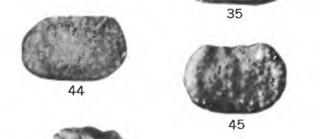
Ostracods, or ostracodes, are a class of the Crustacea, sometimes known as seed shrimp. Some 33,000 species have been identified, grouped into 7 valid orders. They are small crustaceans, typically around 1 mm (0.04 in) in size, but varying from 0.2 to 30 mm in the case of the marine Gigantocypris. The largest known freshwater species is Megalocypris princeps, which reach 8mm in length. In most cases, their bodies are flattened from side to side and protected by a bivalve-like valve or "shell" made of chitin, and often calcium carbonate. The family Entocytheridae and many planktonic forms do not have calcium carbonate. The hinge of the two valves is in the upper (dorsal) region of the body. Ostracods are grouped together based on shell and soft part morphology, and molecular studies have not unequivocally supported the group's monophyly. They have a wide range of diets, and the class includes carnivores, herbivores, scavengers and filter feeders, but most ostracods are deposit feeders.

The Podocopa are a subclass of ostracods. Members of the subclass Podocopa can be differentiated from the other subclass of ostracods (Myodocopa) by the morphology of the second antenna: the Podocopa have a relatively long endopod, whereas the Myodocopa have a relatively long exopod. The seventh limb of the Podocopa has a variety of forms or is absent, but is never an annulated worm-like limb.
Carbonita is an extinct genus of nonmarine ostracod crustaceans that lived during the Carboniferous period.

The Fayetteville Shale is a geologic formation of Mississippian age composed of tight shale within the Arkoma Basin of Arkansas and Oklahoma. It is named for the city of Fayetteville, Arkansas, and requires hydraulic fracturing to release the natural gas contained within.
Ph.D Ali A.F. AL-Furaih was a geology professor at King Saud University. Born in Bukayriyah, Saudi Arabia.
Palaeocopida is an order of ostracods in the subclass Podocopa. Most species in the suborder are extinct, and only the genera Manawa, Promanawa and Puncia in the family Punciidae are extant. The members of the family lives in high-energy shallow marine environments of New Zealand.
Cystodictya is a genus of prehistoric bryozoans in the extinct family Cystodictyonidae.
Betty Kellett Nadeau, born Elizabeth Rosina Kellett, was an American paleontologist and micro-paleontologist who studied Palaeozoic ostracod. Numerous marine species were discovered due to the work she had done throughout her fruitful career. This work is evident to the genus Bekena named after her.
This list of fossil arthropods described in 2018 is a list of new taxa of trilobites, fossil insects, crustaceans, arachnids, and other fossil arthropods of every kind that were described during the year 2018, as well as other significant discoveries, and events related to arthropod paleontology that are scheduled to occur in the year 2018.
Hou Youtang was a Chinese stratigraphic paleontologist and ostracodologist and a member of the Chinese Communist Party. She was a pioneer in micropaleontology research in China and the first Chinese scholar to work on Ostracoda fossils. She is also noted for her major contributions to the oil and gas industry in China.
Crurithyris is an extinct genus of brachiopod belonging to the order Spiriferida and family Ambocoeliidae.
Endothyra is an extinct genus of fusulinid belonging to the family Endothyridae. Specimens of the genus have been found in Carboniferous beds in North America and many other locations in the world. It was a common and widespread rock-forming fusulinid.
Graphiadactyllis is an extinct genus of ostracod belonging to the family Quasillitidae and order Podocopida. Specimens have been found in Mississippian to Permian beds in North America, Europe, and Australia.

Aurikirkbya is an extinct genus of ostracod belonging to the suborder Beyrichicopina and family Kirkbyidae. It is found in Pennsylvanian to Triassic beds in North America, east Asia, southwest Asia, and Europe.
Ceratobairdia is an extinct genus of ostracod belonging to the order Podocopida and family Bairdiidae. Specimens have been found in Permian to Jurassic beds in North America, China, and Europe.
Polytylites is an extinct genus of ostracod belonging to the order Palaeocopida and family Amphissitidae. Specimens have been found in beds of Carboniferous to Permian age in North America and Asia.

Roundyella is an extinct genus of ostracod belonging to the order Leperditellocopida and family Scrobiculidae. Specimens have been found in beds of Devonian to Triassic age in Australia, Asia, Europe, North America, and South America.
Franciszek Adamczak was a Polish–Swedish palaeontologist who made major contributions to the study of Palaeozoic ostracods.
The Gharif Formation is a geologic formation in Oman. It preserves fossils dating back to the Permian period. The Gharif clastic reservoirs are an important hydrocarbon production unit, and the formation is a major producing oil and gas reservoir in Oman.

Acetabulastoma arcticum is a species of an epipelagic ostracod, mostly found associated with sea-ice. It was also referred to as Paradoxostoma rostratum by some early 19th century biologists, Most ostracods are known to be benthic, however, A. arcticum is a parasitic species that has a sympagic association with under sea-ice amphipods.






